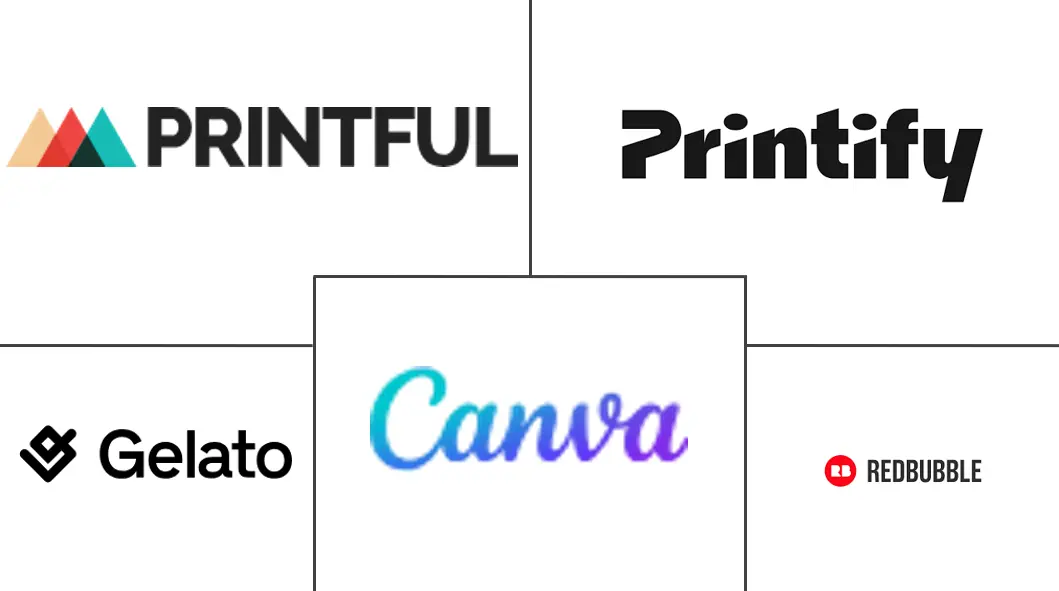Print On Demand Market Size and Share
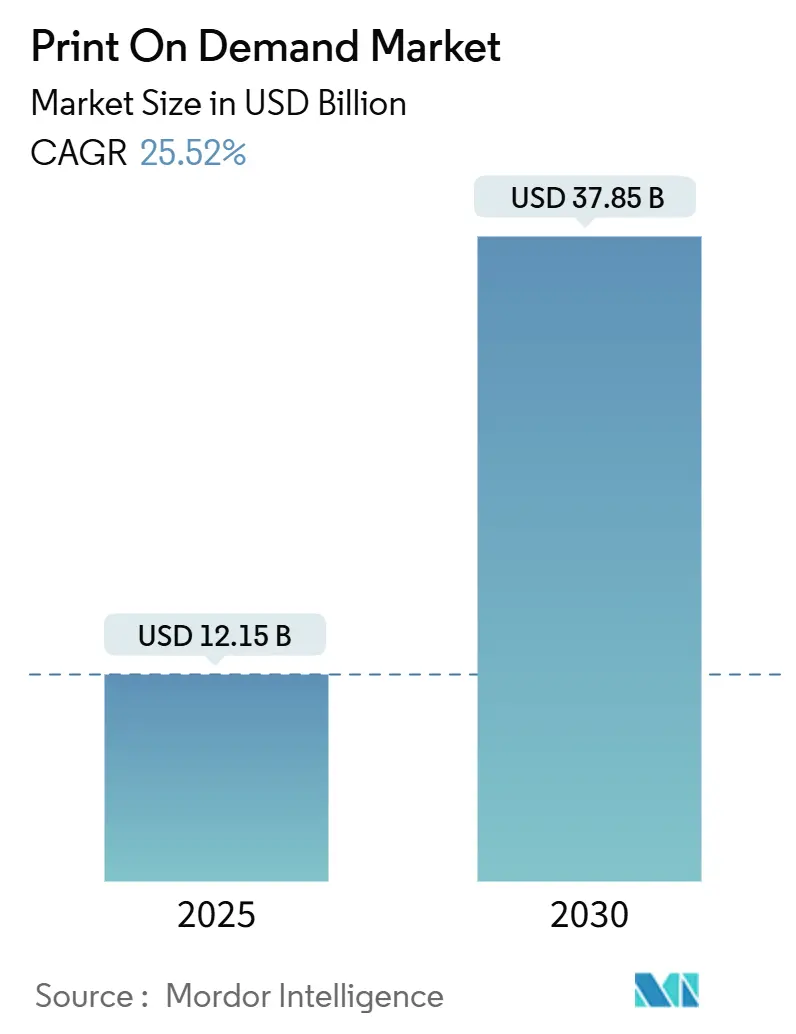
Print On Demand Market Analysis by Mordor Intelligence
The Print-on-Demand market size stood at USD 12.15 billion in 2025 and is forecast to reach USD 37.85 billion by 2030, advancing at a 25.52% CAGR. The sharp trajectory reflects e-commerce maturity, faster digital printing, and policies that reward inventory-free models. Demand accelerates as more than 228,000 active stores seek zero-stock fulfillment, while a 24% three-year survival rate shows the model’s resilience. Software-centric ecosystems, new DTF equipment, and wider generative-AI design options deepen competitive moats. Simultaneously, strict product-safety and extended-producer-responsibility rules in the EU and California favor localized, on-demand output that minimizes waste. North America maintains spending leadership, but Asia-Pacific’s cost edge and adoption of advanced printers generate the fastest regional CAGR.
Key Report Takeaways
- By component, software platforms held 70.24% of the Print-on-Demand market share in 2024; service-based fulfillment posts the quickest 26.72% CAGR to 2030.
- By product type, apparel led with 40.93% revenue share in 2024; home décor is projected to expand at a 27.29% CAGR through 2030.
- By end-user, businesses commanded 74.51% share of the Print-on-Demand market size in 2024, while individual creators record the highest 28.38% CAGR to 2030.
- By printing technology, Direct-to-Garment captured 44.39% share of the Print-on-Demand market size in 2024; Direct-to-Film rises fastest at 29.49% CAGR to 2030.
- By distribution channel, e-commerce marketplaces secured 60.33% of the Print-on-Demand market share in 2024; merchant webstores grow at a 26.68% CAGR to 2030.
- By geography, North America accounted for 40.64% share in 2024, whereas Asia-Pacific registers a 30.34% CAGR through 2030.
Global Print On Demand Market Trends and Insights
Drivers Impact Analysis
| Driver | (~) % Impact on CAGR Forecast | Geographic Relevance | Impact Timeline |
|---|---|---|---|
| Surge in e-commerce SMEs needing zero-inventory fulfilment | +4.2% | Global, with concentration in North America and Europe | Medium term (2-4 years) |
| Rising consumer demand for personalised fashion and gifts | +3.8% | Global, led by North America and Asia-Pacific | Long term (≥ 4 years) |
| Advances in DTG/DTF printing lowering per-unit cost | +3.5% | Global, with early adoption in Asia-Pacific manufacturing hubs | Short term (≤ 2 years) |
| Marketplace integrations accelerating adoption | +3.1% | Global, concentrated in developed e-commerce markets | Medium term (2-4 years) |
| Generative-AI design tools reducing artwork cost and time | +2.9% | Global, with faster adoption in tech-forward regions | Short term (≤ 2 years) |
| Regulatory push for lower inventory waste and carbon footprints | +2.3% | EU and North America leading, expanding to Asia-Pacific | Long term (≥ 4 years) |
| Source: Mordor Intelligence | |||
Surge in e-commerce SMEs Needing Zero-Inventory Fulfilment
Small businesses account for most new sellers yet have limited capital for stock, prompting rapid adoption of Print-on-Demand market solutions. AI-powered forecasting cuts inventory risk by up to 30% and aligns made-to-order output with real demand. [1]Olabode Afolabi, “AI-Driven Business Analytics for SMEs,” International Journal of Science and Research Archive, ijsra.net Seamless links between Shopify’s 62.8% POD store base and fulfillment partners shorten launch times, letting founders switch from idea to storefront within days. Platform ecosystems such as Wix-Printful open zero-inventory access to USD 45.6 billion in potential sales by 2031. These efficiencies underpin a structural preference for digital manufacturing that stays agile during economic volatility.
Rising Consumer Demand for Personalized Fashion and Gifts
Individual expression drives premium spending on bespoke apparel, tote bags, and wall décor. The USD 61 billion wall-art sector is set to double by 2030 as shoppers seek designs reflecting personal milestones.[2]Printful Editorial Team, “Wall Art Trends 2025,” Printful, printful.com Custom products also resonate with corporate buyers looking for differentiated merchandise. Sustainability values magnify the trend, with eco inks and organic blanks reinforcing appeal among younger demographics. Persistent demand for authenticity positions the Print-on-Demand market as a long-cycle growth arena.
Advances in DTG/DTF Printing Lowering Per-Unit Cost
Direct-to-Film eliminates pre-treatment and slashes white-ink usage by 40%, widening material compatibility and shrinking labor inputs. Epson’s SureColor G6070, launched at USD 13,995, brings industrial quality within reach of small workshops. Faster print cycles improve margins and allow micro-run economics previously impossible in the Print-on-Demand industry. As ROI periods compress, adoption accelerates across Asia-Pacific hubs that export globally.
Marketplace Integrations Accelerating Adoption
Plug-and-play APIs automate order routing, tax compliance, and tracking across Amazon, Etsy, and social storefronts. Automation reduces manual touches, which can consume 20-30% of processing time in legacy systems. Headless commerce setups further customise front-end experiences without sacrificing back-end fulfillment scale. The result is a frictionless Print-on-Demand market onboarding path that lowers barriers for creators and brands alike.
Restraints Impact Analysis
| Restraint | (~) % Impact on CAGR Forecast | Geographic Relevance | Impact Timeline |
|---|---|---|---|
| Intensifying price competition squeezing margins | -2.8% | Global, most acute in mature markets | Short term (≤ 2 years) |
| Quality-consistency and returns management challenges | -2.1% | Global, with higher impact in premium segments | Medium term (2-4 years) |
| Cross-border micro-parcel customs delays | -1.9% | International markets, particularly US-EU-Asia corridors | Medium term (2-4 years) |
| Source: Mordor Intelligence | |||
Intensifying Price Competition Squeezing Margins
Low entry barriers lead to heavy discounting, pulling average seller margins near 20%. Polyester fiber price swings and cotton supply pressure add cost volatility. Platform fees absorb up to one-quarter of gross revenue, forcing operators to find edge through niche focus or superior service. Although the Fyul merger may stabilise pricing, smaller providers must differentiate to avoid a race to the bottom.
Quality-Consistency and Returns Management Challenges
Dispersed production networks complicate standardisation. Variability can spark higher return rates that erode profits. Fujifilm highlights the need for tight pre-press checks and calibrated machinery. [3]Fujifilm Graphics, “Overcoming Common Print-On-Demand Problems,” Fujifilm, print-us.fujifilm.comAutomated inspection and detailed material specs are becoming baseline requirements. Premium segments, where customer tolerance is low, feel the impact most acutely.
Segment Analysis
By Component: Software Platforms Drive Market Integration
Software platforms generated 70.24% of 2024 revenue, anchoring the Print-on-Demand market with middleware that unifies storefronts, designers, and factories. Robust APIs feed real-time inventory, automate tax, and push label data to hundreds of carriers. Such orchestration compresses fulfilment cycles and minimises human error.
Momentum continues as vendors embed AI that predicts trending designs and automates pricing. Service-based fulfillment, expanding at 26.72% CAGR, attracts brands that prefer outsourcing logistics and QC. White-label dashboards, SLA guarantees, and embedded sustainability metrics explain the shift, especially for SMEs lacking IT staff.
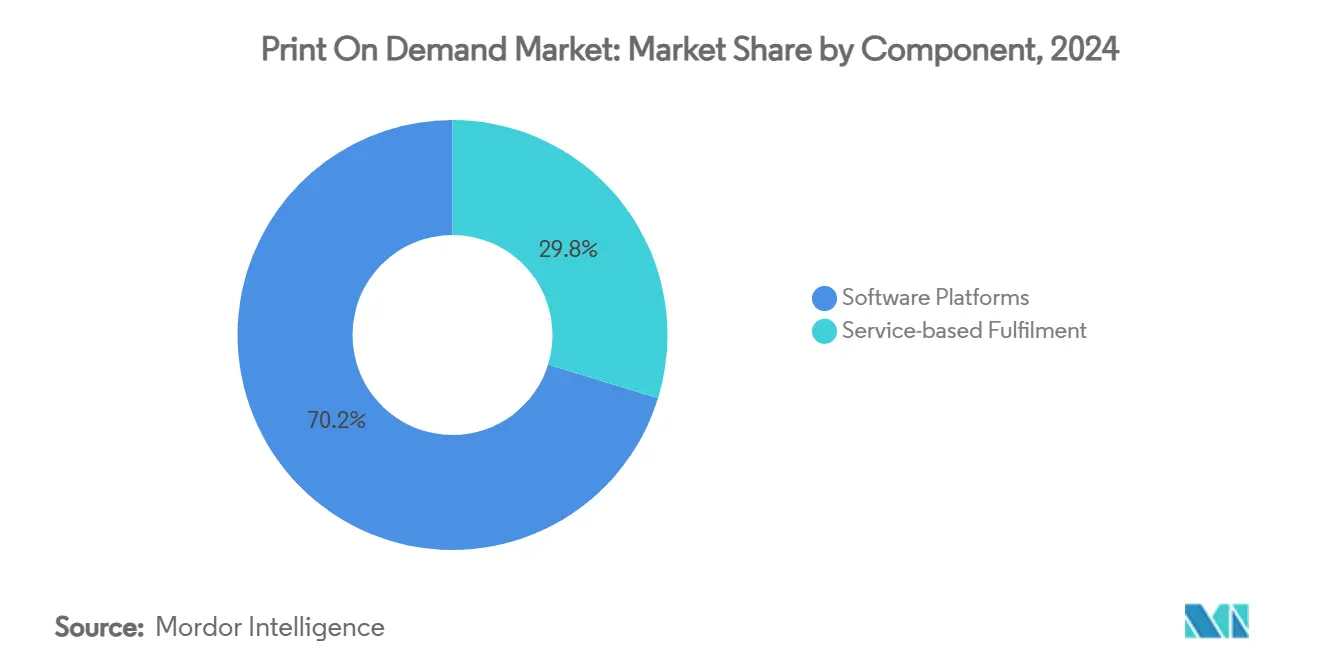
By Product Type: Home Décor Disrupts Apparel Dominance
Apparel retained 40.93% share in 2024, yet saturation and thin margins encourage portfolio broadening. Home décor is growing at 27.29% CAGR, recasting living spaces as canvases for self-expression. Wall art alone could elevate the Print-on-Demand market size for décor items to USD 24 billion by 2030, reflecting remote-work lifestyle upgrades.
Versatile DTF and dye-sublimation let providers decorate canvas, glass, and metal, fostering premium price points. Bundle strategies—such as coordinated pillow, throw, and print sets—raise average order value and deepen customer loyalty. Merchandisers view décor as hedge against apparel price wars.
By End-User: Individual Creators Challenge Business Dominance
Corporations generated 74.51% of 2024 revenue via branded merchandise and marketing giveaways, safeguarding incumbency. Yet individual creators grow at 28.38% CAGR, fuelled by social platforms that convert followers into buyers. Creator-first toolkits, one-click sample ordering, and transparent royalty dashboards invite newcomers.
Businesses still rely on Print-on-Demand market agility for seasonal campaigns and event-specific drops. However, creator communities pioneer micro-niche designs, teaching incumbents the value of data-driven curation. A feedback loop of rapid testing and limited-run scarcity maintains high engagement and repeat purchasing.
By Printing Technology: DTF Disrupts Traditional Methods
Direct-to-Garment held 44.39% of the Print-on-Demand market size in 2024, but DTF’s 29.49% CAGR signals a pivot. Eliminating pre-treatment lowers labor, while broader fabric compatibility multiplies SKU potential. Users cite a 30% throughput lift after switching to DTF setups such as M&R Polaris.
Hybrid presses blend DTG, DTF, and UV curing, letting operators switch modes on one line and shrink capex. Dye-sublimation remains vital for all-over polyester prints, especially in sportswear and promotional flags, anchoring a balanced technology mix across segments.
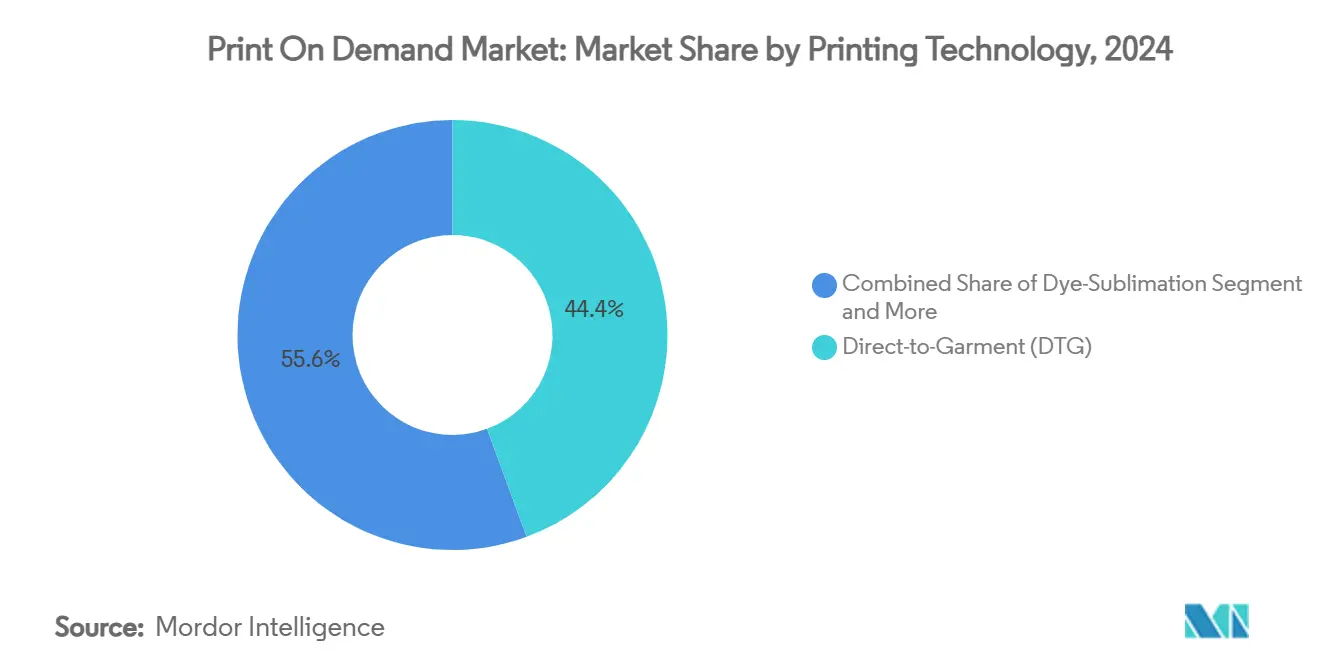
Note: Segment shares of all individual segments available upon report purchase
By Distribution Channel: Merchant Webstores Gain Ground
Marketplaces delivered 60.33% of 2024 revenue through built-in traffic and trust factors, yet reliance on algorithm visibility and commission fees motivates diversification. Merchant webstores, scaling at 26.68% CAGR, safeguard margins and harvest first-party data.
Payment gateways now offer instant lender underwriting, funding ad budgets tied to real-time performance. Unified inventory pools serve both channels, with smart routing steering orders to the nearest plant. The dual-track model mitigates platform risk and boosts lifetime value per customer.
Geography Analysis
North America claimed 40.64% share in 2024 on the back of mature e-commerce habits, sophisticated logistics, and high disposable income. California’s textile recovery law raises compliance costs for traditional bulk importers, nudging brands toward the Print-on-Demand market for sustainable proof points. Removal of the de minimis threshold will inflate inbound duty bills, steering sellers to Mexican near-shore hubs that cut transit time and duties.
Asia-Pacific delivers the highest 30.34% CAGR to 2030. China leverages clustered supply chains and rapid DTF uptake to compress production cost curves, enabling local firms to export short runs competitively. Japan’s technology showcases, such as the 2025 Printing Voyage, spotlight continuous innovation, while India scales digitally connected textile mills serving both domestic and export demand.
Europe’s growth centers on regulatory alignment and eco mandates that value low-inventory practices. The EU General Product Safety Regulation and the 2025-2030 Ecodesign work plan elevate documentation and recyclability requirements. Providers like Gelato meet the challenge by producing 85% of orders within the destination region, curbing freight emissions and winning eco-conscious buyers.
Competitive Landscape
Platform consolidation peaked in January 2025 when Printful and Printify merged to form Fyul, pooling catalogs, funding, and 10-million-seller reach. The union promises deeper automation, but also raises seller worries about fee hikes and policy shifts. Fyul’s scale pushes rivals to differentiate through hyper-local production and specialty substrates.
Gelato positions itself as sustainability champion, operating 140+ hubs across 32 countries and quoting 72-hour delivery windows for 97% of orders. The firm enhanced creator tools that auto-select optimal print sites based on carbon and cost metrics. Smaller entrants focus on vertical niches—luxury stationery or technical workwear—where bespoke materials and compliance needs insulate margins.
Technological IP remains a moat; Epson’s Micro TFP head patents lock in print-quality leadership, while independent software vendors file claims on AI colour calibration and demand-forecasting algorithms. Venture funding remains robust: Printify’s USD 50 million Series A underwrote R&D and expansion even amid tighter capital markets. Outcome diversification signals a competitive yet opportunity-rich Print-on-Demand market.
Print On Demand Industry Leaders
-
Printful Inc.
-
Printify Inc.
-
Canva Pty Ltd.
-
Gelato AS
-
Redbubble Inc.
- *Disclaimer: Major Players sorted in no particular order
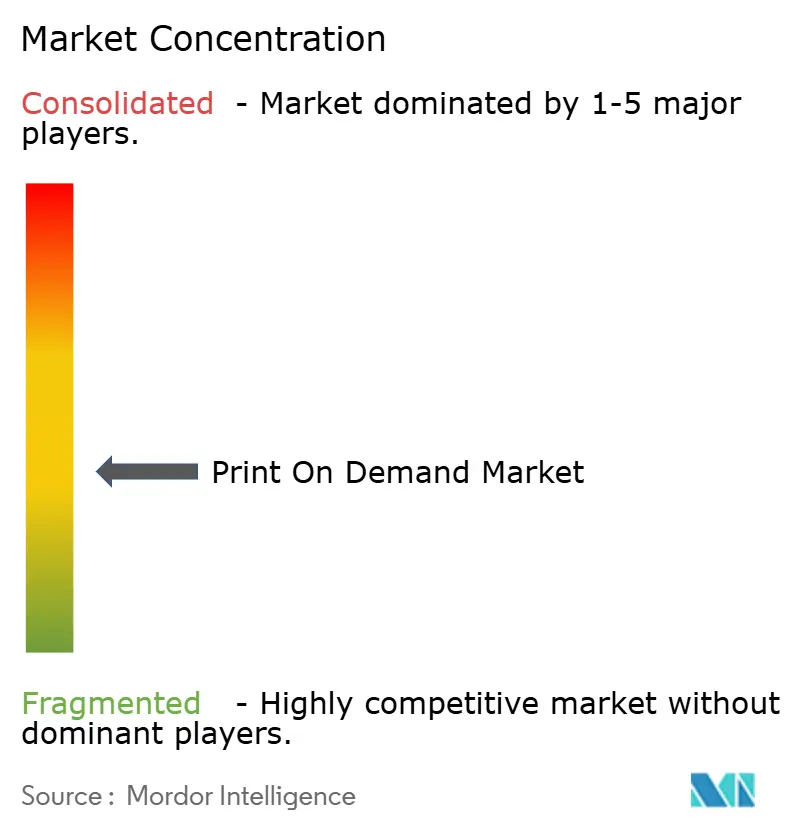
Recent Industry Developments
- April 2025: Epson launched the SureColor G6070 DTF printer with 35.4-inch width and OEKO-TEX-certified inks, priced at USD 13,995.
- March 2025: Wix unveiled native Printful integration, opening a USD 45.6 billion sales opportunity for its users.
- January 2025: Printful and Printify finalised their merger to form Fyul, combining product lines and global plants.
- January 2025: The EU activated textile extended-producer-responsibility mandates, reinforcing demand-driven production.
Global Print On Demand Market Report Scope
Print on demand (POD) is a business model and printing technology that allows for the production of items only after an order is received. Products such as apparel, accessories or home decor are customized and sold only upon order. The research also examines underlying growth influencers and significant industry vendors, all of which help to support market estimates and growth rates throughout the anticipated period. The market estimates and projections are based on the base year factors and arrived at top-down and bottom-up approaches.
The print on demand market is segmented by platform (Software and Services), by product type (Apparel, Home Decor, Drinkware, and Accessories), and geography (North America, Europe, Asia Pacific, South America, and Middle East & Africa). The market sizing and forecasts are provided in terms of value (USD) for all the above segments.
| Software Platforms |
| Service-based Fulfilment |
| Apparel |
| Home Decor |
| Drinkware |
| Accessories |
| Wall-Art and Print Media |
| Businesses (B2B, DTC brands) |
| Individuals and Creators |
| Direct-to-Garment (DTG) |
| Dye-Sublimation |
| Direct-to-Film (DTF) |
| Other Print Technology |
| E-commerce Marketplaces |
| Merchant-owned Webstores |
| North America | United States | |
| Canada | ||
| Mexico | ||
| Europe | Germany | |
| France | ||
| Italy | ||
| Spain | ||
| United Kingdom | ||
| Russia | ||
| Rest of Europe | ||
| Asia-Pacific | China | |
| India | ||
| Japan | ||
| South Korea | ||
| Australia | ||
| Rest of Asia-Pacific | ||
| Middle East and Africa | Middle East | Saudi Arabia |
| United Arab Emirates | ||
| Turkey | ||
| Rest of Middle East | ||
| Africa | South Africa | |
| Nigeria | ||
| Rest of Africa | ||
| South America | Brazil | |
| Argentina | ||
| Rest of South America | ||
| By Component | Software Platforms | ||
| Service-based Fulfilment | |||
| By Product Type | Apparel | ||
| Home Decor | |||
| Drinkware | |||
| Accessories | |||
| Wall-Art and Print Media | |||
| By End-User | Businesses (B2B, DTC brands) | ||
| Individuals and Creators | |||
| By Printing Technology | Direct-to-Garment (DTG) | ||
| Dye-Sublimation | |||
| Direct-to-Film (DTF) | |||
| Other Print Technology | |||
| By Distribution Channel | E-commerce Marketplaces | ||
| Merchant-owned Webstores | |||
| By Geography | North America | United States | |
| Canada | |||
| Mexico | |||
| Europe | Germany | ||
| France | |||
| Italy | |||
| Spain | |||
| United Kingdom | |||
| Russia | |||
| Rest of Europe | |||
| Asia-Pacific | China | ||
| India | |||
| Japan | |||
| South Korea | |||
| Australia | |||
| Rest of Asia-Pacific | |||
| Middle East and Africa | Middle East | Saudi Arabia | |
| United Arab Emirates | |||
| Turkey | |||
| Rest of Middle East | |||
| Africa | South Africa | ||
| Nigeria | |||
| Rest of Africa | |||
| South America | Brazil | ||
| Argentina | |||
| Rest of South America | |||
Key Questions Answered in the Report
What is the current size of the Print-on-Demand market?
The Print-on-Demand market size reached USD 12.15 billion in 2025 and is on track to hit USD 37.85 billion by 2030.
Which region grows the fastest in Print-on-Demand?
Asia-Pacific registers the quickest expansion with a 30.34% CAGR through 2030 thanks to cost-efficient manufacturing and rapid technology uptake.
Why is Direct-to-Film printing gaining popularity?
DTF removes pre-treatment steps, cuts white-ink use by 40%, works on more fabrics, and raises throughput, leading to a 29.49% CAGR in this segment.
How will ending the USD 800 de minimis rule affect sellers?
Sellers shipping to the United States will face higher duties on small parcels, which may prompt them to shift production closer to US customers.
What advantages do merchant webstores provide over marketplaces?
Owned sites avoid commission fees, grant full customer-data access, and allow tailored branding, driving a 26.68% CAGR for this channel.
Page last updated on:
